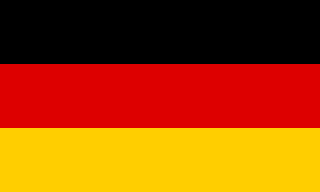 W
WAfter the defeat of Germany in World War II, the country was divided between the two global blocs in the East and West, a period known as the division of Germany. Germany was stripped of its war gains and lost territories in the east to Poland and the Soviet Union. At the end of the war, there were some eight million foreign displaced persons in Germany; mainly forced laborers and prisoners; including around 400,000 from the concentration camp system, survivors from a much larger number who had died from starvation, harsh conditions, murder, or being worked to death. Over 10 million German-speaking refugees arrived in Germany from other countries in Central and Eastern Europe. Some 9 million Germans were POWs, many of whom were kept as forced laborers for several years to provide restitution to the countries Germany had devastated in the war, and some industrial equipment was removed as reparations.
 W
WThe history of Germany since 1990 spans the period following the Reunification of Germany, when West Germany and East Germany were reunited after being divided during the Cold War. Germany after 1990 is referred to by historians as the Berlin Republic. This time period is also determined by the ongoing process of the "inner reunification" of the formerly divided country.
 W
WThe industrial plans for Germany were designs the Allies considered imposing on Germany in the Aftermath of World War II to reduce and manage Germany's industrial capacity.
 W
WThe Bielefeld conspiracy is a satirical conspiracy theory that claims that the city of Bielefeld, Germany, does not exist, but is an illusion propagated by various forces. First posted on the German Usenet in 1994, the conspiracy has since been mentioned in the city's marketing, and alluded to in a speech by Chancellor Angela Merkel.
 W
WThe Bitburg controversy concerned a ceremonial visit by Ronald Reagan, the incumbent President of the United States, to a German military cemetery in Bitburg, West Germany in May 1985. The visit was intended to commemorate the 40th anniversary of the end of World War II in Europe but aroused considerable criticism in the United States and around the world when it became known that 49 of the 2,000 German soldiers buried at the site had been members of the Waffen-SS, the military arm of Nazi Germany's Schutzstaffel (SS). The entire SS was judged to be a criminal organisation at the Nuremberg trials. The fact that Reagan had not been scheduled to visit former concentration camps compounded the controversy and a trip to Bergen-Belsen concentration camp was later added to his itinerary.
 W
WGerman reunification was the process in 1990 in which the German Democratic Republic (GDR) became part of the Federal Republic of Germany (FRG) to form the reunited nation of Germany.
 W
WThe history of Germany since 1990 spans the period following the Reunification of Germany, when West Germany and East Germany were reunited after being divided during the Cold War. Germany after 1990 is referred to by historians as the Berlin Republic. This time period is also determined by the ongoing process of the "inner reunification" of the formerly divided country.
 W
WThe Peaceful Revolution was the process of sociopolitical change that led to the opening of East Germany's borders with the west, the end of the Socialist Unity Party of Germany (SED) in the German Democratic Republic and the transition to a parliamentary democracy, which enabled the reunification of Germany in October 1990. This happened through non-violent initiatives and demonstrations. This period of change is also referred to in German as Die Wende.
 W
WThe reconstruction of Germany after World War II was a long process after Hitler's suicide, which had ended the war. Germany had suffered heavy losses during the war, both in lives and industrial power. 6.9 to 7.5 million Germans had been killed, roughly 8.26 to 8.86% of the population. The country's cities were severely damaged from heavy bombing in the closing chapters of the war and agricultural production was only 35% of what it was before the war.
 W
WWest Germany is the common English name for the Federal Republic of Germany, retrospectively designated the Bonn Republic, in the period between its formation on 23 May 1949 and German reunification on 3 October 1990. During this Cold War period, the western portion of Germany was part of the Western Bloc. West Germany was formed as a political entity during the Allied occupation of Germany after World War II, established from eleven states formed in the three Allied zones of occupation held by the United States, the United Kingdom and France. Its provisional capital was the city of Bonn.
 W
WAfter World War II both West Germany and East Germany were obliged to pay war reparations to the Allied governments, according to the Potsdam Conference. First provisionally but later finally, Germany ceded a quarter of its territory as defined by its 1937 borders to Poland and the Soviet Union. Other Axis nations were obliged to pay war reparations according to the Paris Peace Treaties, 1947.